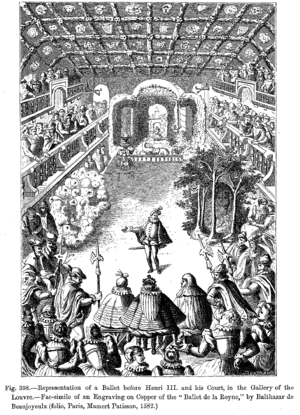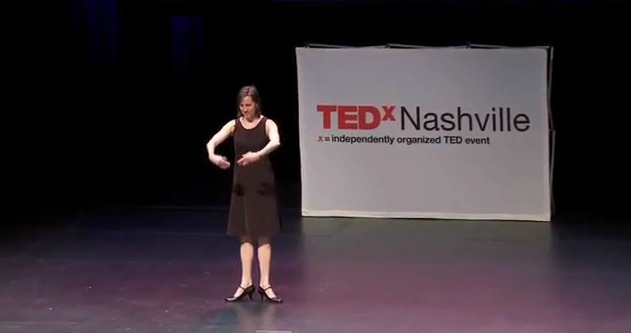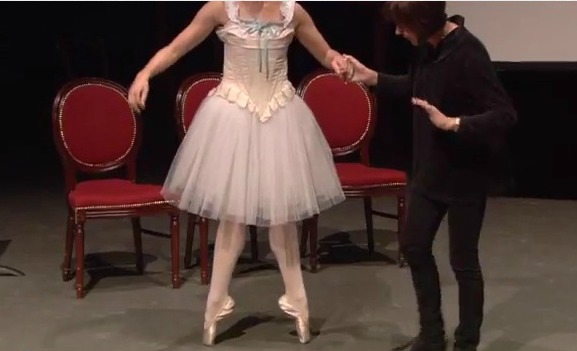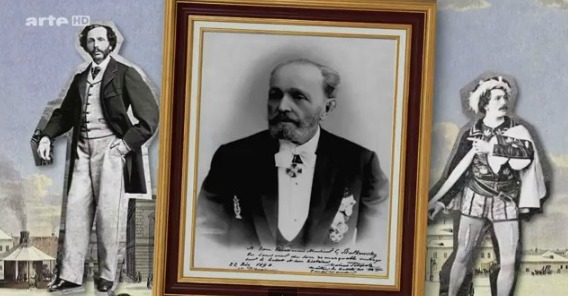![An Evening with Marius Petipa [Video]](../../wp-content/uploads/2014/02/220px-Marius_Ivanovich_Petipa_-Feb._14_1898.jpg)
by Romy Macias, Senior Editor | Feb 6, 2014 | Ballet Dancers, Ballet History
Be prepared to enjoy over an hour of homage to the greatest ballet master of all time, Marius Petipa. An Evening with Marius Petipa Victor Marius Alphonse Petipa (11 March 1818 – 14 July 1910) was a French ballet dancer, teacher and choreographer. Petipa is considered to be the most influential ballet master and choreographer of ballet. Marius Petipa is noted for his long career as premier maître de ballet of the St. Petersburg Imperial Theatres, a position he held from 1871 until 1903. Petipa created over fifty ballets, some of which have survived in versions either faithful to, inspired by, or reconstructed from the original. The Pharaoh’s Daughter (1862) Don Quixote (1869) La Bayadère (1877) Le Talisman (1889) The Sleeping Beauty (1890) The Nutcracker (which was most likely choreographed by Lev Ivanov, perhaps with Petipa’s counsel and instruction) (1892) Le Réveil de Flore (1894) La Halte de cavalerie (1896) Raymonda (1898); Les Saisons(1900) Les Millions d’Arlequin (a.k.a. Harlequinade) (1900) Petipa revived a substantial number of works created by other Ballet Masters. Many of these revivals would go on to become the definitive editions from which all subsequent productions would be based. The most famous of these revivals are Le Corsaire, Giselle,La Esmeralda, Coppélia, La Fille Mal Gardée (with Lev Ivanov), The Little Humpbacked Horse and Swan Lake (with Lev Ivanov). For more on Marius Petipa, his life and work visit wikipedia.org. An Evening with Marius Petipa In the first portion of this gala the Kirov dances La Bayadere (Kingdom of Shades), followed by Paquita. Gala Marius Petipa featuring Viktoria Tereshkina and Alina Somova Video courtesy of YouTube. An Evening with Marius Petipa If you’ve enjoyed this homage to Petipa give us a “Like” below and “Share” with your friends. Until next Thursday!...
by Romy Macias, Senior Editor | Jun 24, 2012 | Ballet History, Classical Ballet
Hedy Weiss, Dance Critic with the Chicago Sun Times reports on the upcoming Paris Opera Tour, starting June 26. I really enjoyed her article as she provides a short but concise history of classical ballet. Then she follows with dates and cities where the Paris Opera will tour the U.S. Paris Opera will tour the U.S. First, a quick pirouette through history: Although ballet is believed to have begun in the courts of the Italian Renaissance, credit for what we now think of as the art of classical ballet must really go to King Louis XIV of France (“The Sun King”). An enthusiastic dancer and performer himself, in 1661 he founded the Academie Royale de Danse (Royal Dance Academy) and charged it with establishing standards for the art of dance and the certification of dance teachers. Later, he appointed composer and dancer Jean-Baptiste Lully to the post of director of the Academie Royale de Musique (the Paris Opera), and out of this grew the Paris Opera Ballet, the company that now can lay claim to being the world’s first professional ballet company. So, history alone is a crucial reason why the visit this week by the Paris Opera Ballet to Chicago’s Harris Theater for Music and Dance has generated so much anticipation and excitement. The massive company’s engagement here (the first in many decades) also will serve as the kickoff for a rare U.S. tour that subsequently will make stops in Washington, D.C., and New York. The french company will be presenting: Giselle and three 20th century pieces: Suite en Blanc, L’Arlesienne and Bolero. Twenty-five performances starting June 26 until July...

by Romy Macias, Senior Editor | Feb 26, 2012 | Ballet History
What are the origins of the word ballet? Is it French or Italian? The definition of ballet comes from the Italian. (Most answer French at first and that’s because ballet terminology is in French, most of us quickly assume the word ballet also comes from the French language!) Actually the word ballet comes from balletto, meaning small dance in Italian. Dr. Giannandrea Poesio, historian and dance critic, who writes for the Royal Opera House, explains: Definition of Ballet Ballet: from the Italian ‘balletto’, diminutive of ‘ballo’, or ‘dance’. The term, as synonymous with a ‘small dance spectacle’ became fashionable in the second half of the 16th century, with court entertainments such as the 1573 Ballet de Polonais (ballet of the Polish Ambassadors) a seminal predecessor of the more famous Ballet Comique de la Royne. Complete text here. Test your knowledge of ballet terminology. Did you know the origins and definition of ballet? The first time I was asked this question I answered French! Click the white “Share” button below and get your friends involved. What a fun way to learn more about classical ballet and it’s origins! Grazie. 🙂 Image source: http://www.gutenberg.org/files/10940/10940-h/images/fig398.png Figure 138 in Paul Lacroix, aka Bibliophile Jacob (1874). Manners, Customs, and Dress During the Middle Ages and During the Renaissance Period, available freely at Project Gutenberg. Curious about learning more on the history and origins of ballet, it’s technique, evolution of pointe shoes and more? Click...

by Romy Macias, Senior Editor | Feb 24, 2012 | Ballet History, Ballet Media, Editor's Choice
Former ballerina, historian and dance critic, Jennifer Homans has been passionate about ballet her entire life. She began her dancing career at 8 and danced professionally until the age of 26. Her latest book, Apollo’s Angels reveals her insights on the history of ballet. Her views are fascinating, to say the least. After 15 years of intense investigation, she has arrived to interesting conclusions. Follow the article and video below. The History of Ballet A dance critic for The New Republic, Homans earned her Ph.D. in modern European history at New York University, where she is a distinguished scholar-in-residence, teaching the history of ballet. In an earlier incarnation, she was a professional dancer, performing with the Chicago Lyric Opera Ballet and the San Francisco Ballet [and the Pacific Northwest Ballet]. “When I was myself a dancer looking for things to read, I did not find a cultural history that was broad about politics, ideas and the arts as well as about dance,” Homans said in a phone interview about Apollo’s Angels, which was 15 years in research and writing. “So when I stopped dancing and became an historian, over time I realized I had the equipment, the training and experience in dance and history, to write the book I always wanted to read.” Rita Kohn‘s original interview can be found here by following this link. In her book, Apollo’s Angels, the ballet critic asks: Why should we care about ballet? Jennifer Homans tells us what ballet means to her, as a dancer and as a historian, and why she has devoted her life to understanding this beautiful and civilizing...

by Romy Macias, Senior Editor | Jan 5, 2012 | Ballet History, Editor's Choice, Pointe Shoes
The Royal Opera House and the Royal Academy of Arts presented ballet Mistress Ursula Hageli’s analysis of the evolution of classical ballet technique through the paintings of Degas dancers. An excited Ms. Hageli shared her findings with the help of Royal Ballet dancers Leanne Cope and Lauren Cuthbertson; Leanne representing the Degas-style dancer and Lauren the modern day ballerina. Marie Taglioni was the first ballerina to go on her toes. Toe shoes were still very soft, no block, only darned at the tips. Dancers would only rise on their toes for a brief moment. Back then, ballerinas did not pirouette on their toes as they do today. Taglioni trained with her father who boasted that she was light on her feet and also very chaste. By Degas’ time the length of ballet skirts had shortened to above the calf and had to be used with bloomers. Any family man could bring their entire family and even at the height of her (Taglioni’s) jumps they would not be able to see her knees. Hageli adds that dancers also used corsets which limited the range of movement of their torsos as well as their arms, thus their more rounded port de bras and slightly forward-tilted stance. The evolution of classical ballet technique dates back to Louis XV’s court. It is in the tradition of classical ballet that technique is passed on directly Enrico Cecchetti having been taught by Giovanni Lepri who was taught by Carlo Blasis and the line can be traced back to Beauchamp the first ballet master at the court of Louis XV. Wikipedia.org Blasis developed a treatise of...
by Romy Macias, Senior Editor | Dec 23, 2011 | Ballet History, Classical Ballet
Earlier this month in Buenos Aires, Argentina, renown dance historian for the CNB, Miguel Cabrera, launched his latest treasure: Ballet in Cuba, Birth of a School in the 20th Century, (‘El Ballet en Cuba. Nacimiento de una Escuela en el Siglo XX’), abook in which the history of the Cuban National Ballet is documented. Cabrera writes in detail from its birth spanning six decades of the Cuban ballet, beginning with the 19th century. For the first time in Latin America has a book like this been published on the BNC, containing the company’s most significant events. Ballet in Cuba, Birth of a School in the 20th Century The book, which has a remarkable photographic support, is divided into nine chapters. The first three are ‘Ballet in the Colonial Cuba: a Historic Sketch’, ‘Two Landmarks in the Republic: Coppelia and Anna Pavlova’s Visits’, and ‘An Approach to the Ballet School of the Musical Pro-Art Society of Havana’. The others are ‘The Alonso Triad’, ‘The Cuban Jewels’, ‘Maria Elena Llorente and Marta Garcia: in the Path of the Great Legacy’, ‘The Three Cuban Graces’, ‘From Jorge Esquivel to Carlos Acosta: Consolidation of a Stock’, and ‘The National Ballet of Cuba: Six Decades of Glory’. Follow link to article. I look forward to reading this book soon. I did a quick search for it in Amazon.com and BarnesandNobles.com…not luck.nHopefully it will be available in the near future to all ballet admirers everywhere. To be able to “travel in time” through Miguel Cabrera’s eyes and witness the genesis of what today is known as one of the strongest ballet companies in the world...
![An Evening with Marius Petipa [Video]](../../wp-content/uploads/2014/02/220px-Marius_Ivanovich_Petipa_-Feb._14_1898.jpg)
![An Evening with Marius Petipa [Video]](../../wp-content/uploads/2014/02/220px-Marius_Ivanovich_Petipa_-Feb._14_1898.jpg)




